英语语法汇总及归纳
- 格式:docx
- 大小:13.50 KB
- 文档页数:3
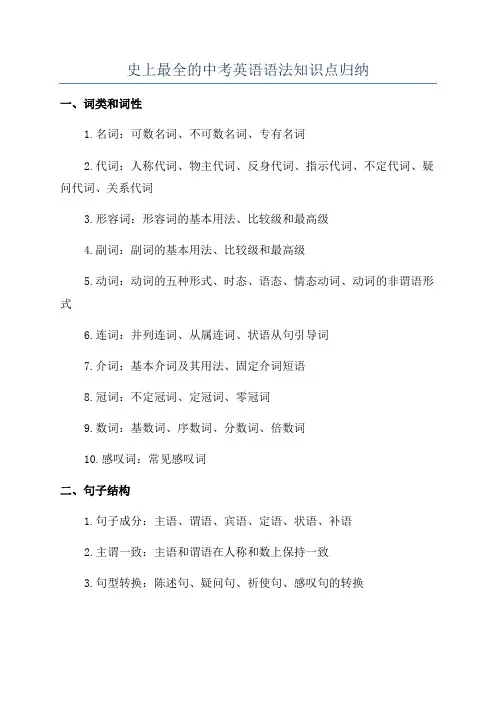
史上最全的中考英语语法知识点归纳一、词类和词性1.名词:可数名词、不可数名词、专有名词2.代词:人称代词、物主代词、反身代词、指示代词、不定代词、疑问代词、关系代词3.形容词:形容词的基本用法、比较级和最高级4.副词:副词的基本用法、比较级和最高级5.动词:动词的五种形式、时态、语态、情态动词、动词的非谓语形式6.连词:并列连词、从属连词、状语从句引导词7.介词:基本介词及其用法、固定介词短语8.冠词:不定冠词、定冠词、零冠词9.数词:基数词、序数词、分数词、倍数词10.感叹词:常见感叹词二、句子结构1.句子成分:主语、谓语、宾语、定语、状语、补语2.主谓一致:主语和谓语在人称和数上保持一致3.句型转换:陈述句、疑问句、祈使句、感叹句的转换4.句子的简单句、并列句、复合句、复合句类型(定语从句、状语从句、宾语从句)三、时态和语态1.一般现在时2.一般过去时3.现在进行时4.过去进行时5.一般将来时6.一般过去将来时7.现在完成时8.过去完成时9.现在完成进行时10.一般过去完成进行时11.被动语态四、非谓语动词1.不定式2.动名词3.动词-ing形式五、虚拟语气1.与事实相反的虚拟语气:与现在事实相反的虚拟语气、与过去事实相反的虚拟语气2.与将来事实相反的虚拟语气3.与现在条件相反的虚拟语气4.与过去条件相反的虚拟语气六、定语从句1.关系代词引导的定语从句2.关系副词引导的定语从句3.定语从句的嵌套七、状语从句1.时间状语从句2.地点状语从句3.方式状语从句4.原因状语从句5.条件状语从句6.比较状语从句7.目的状语从句8.结果状语从句八、宾语从句1.宾语从句的引导词2.宾语从句的位置九、名词性从句1.主语从句2.宾语从句3.表语从句十、情态动词1.can和could2.may和might3.will和would4.shall和should5.must和have to6.need和dare以上是中考英语语法知识点的简要归纳,更详细的内容需要根据课本和学习资料进行学习和理解。

史上最全的中考英语语法必考知识点归纳一、词类、句子成分和构词法:1、词类:英语词类分十种:名词、形容词、代词、数词、冠词、动词、副词、介词、连词、感叹词。
1、名词(n.):表示人、事物、地点或抽象概念的名称。
如:boy, morning, bag, ball, class, orange.2、代词(pron.):主要用来代替名词。
如:who, she, you, it .3、形容词(adj..):表示人或事物的性质或特征。
如:good, right, white, orange .4、数词(num.):表示数目或事物的顺序。
如:one, two, three, first, second, third, fourth.5、动词(v.):表示动作或状态。
如:am, is,are,have,see .6、副词(adv.):修饰动词、形容词或其他副词,说明时间、地点、程度等。
如:now, very, here, often, quietly, slowly.7、冠词(art..):用在名词前,帮助说明名词。
如:a, an, the.8、介词(prep.):表示它后面的名词或代词与其他句子成分的关系。
如in, on, from, above, behind.9、连词(conj.):用来连接词、短语或句子。
如and, but, before .10、感叹词(interj..)表示喜、怒、哀、乐等感情。
如:oh, well, hi, hello.2、句子成分:英语句子成分分为七种:主语、谓语、宾语、定语、状语、表语、宾语补足语。
1、主语是句子所要说的人或事物,回答是“谁”或者“什么”。
通常用名词或代词担任。
如:I’m Miss Green.(我是格林小姐)2、谓语动词说明主语的动作或状态,回答“做(什么)”。
主要由动词担任。
如:Jack cleans the room every day. (杰克每天打扫房间)3、表语在系动词之后,说明主语的身份或特征,回答是“什么”或者“怎么样”。

初中英语语法归纳总结一、词类、句子成分和构词法:1、词类:英语词类分种:名词、形容词、代词、数词、冠词、动词、副词、介词、连词、感叹词。
1、名词(n、):表示人、事物、地点或抽象概念的名称。
如:boy, morning, bag, ball, class, orange、2、代词(pron、):主要用来代替名词。
如:who, she, you, it 、3、形容词(adj、、):表示人或事物的性质或特征。
如:good, right, white, orange 、4、数词(num、):表示数目或事物的顺序。
如:one, two, three, first, second, third, fourth、5、动词(v、):表示动作或状态。
如:am, is,are,have,see 、6、副词(adv、):修饰动词、形容词或其他副词,说明时间、地点、程度等。
如:now, very, here, often, quietly, slowly、7、冠词(art、、):用在名词前,帮助说明名词。
如:a, an, the、8、介词(prep、):表示它后面的名词或代词与其他句子成分的关系。
如in, on, from, above, behind、9、连词(conj、):用来连接词、短语或句子。
如and, but, before 、10、感叹词(interj、、)表示喜、怒、哀、乐等感情。
如:oh, well, hi, hello、2、句子成分:英语句子成分分为七种:主语、谓语、宾语、定语、状语、表语、宾语补足语。
1、主语是句子所要说的人或事物,回答是“谁”或者“什么”。
通常用名词或代词担任。
如:I’m Miss Green、(我是格林小姐)2、谓语动词说明主语的动作或状态,回答“做(什么)”。
主要由动词担任。
如:Jack cleans the room every day、 (杰克每天打扫房间)3、表语在系动词之后,说明主语的身份或特征,回答是“什么”或者“怎么样”。
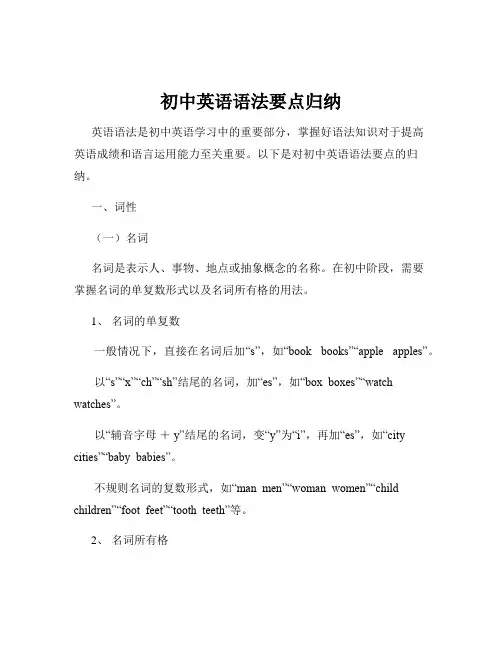
初中英语语法要点归纳英语语法是初中英语学习中的重要部分,掌握好语法知识对于提高英语成绩和语言运用能力至关重要。
以下是对初中英语语法要点的归纳。
一、词性(一)名词名词是表示人、事物、地点或抽象概念的名称。
在初中阶段,需要掌握名词的单复数形式以及名词所有格的用法。
1、名词的单复数一般情况下,直接在名词后加“s”,如“book books”“apple apples”。
以“s”“x”“ch”“sh”结尾的名词,加“es”,如“box boxes”“watch watches”。
以“辅音字母+y”结尾的名词,变“y”为“i”,再加“es”,如“city cities”“baby babies”。
不规则名词的复数形式,如“man men”“woman women”“child children”“foot feet”“tooth teeth”等。
2、名词所有格表示有生命的名词所有格,一般在名词后加“'s”,如“Tom's book”“my mother's bag”。
以“s”结尾的复数名词,直接加“'”,如“the students' books”。
表示无生命的名词所有格,常用“of +名词”的结构,如“the window of the room”。
(二)动词动词是表示动作或状态的词。
在初中阶段,需要重点掌握动词的时态和语态。
1、时态一般现在时:表示经常发生的动作或存在的状态。
主语是第三人称单数时,动词要加“s”或“es”,如“He studies hard”。
一般过去时:表示过去发生的动作或存在的状态。
动词要用过去式,如“I played basketball yesterday”。
一般将来时:表示将来要发生的动作或存在的状态。
常用“will +动词原形”或“be going to +动词原形”的结构,如“He will come tomorrow”“I'm going to visit my grandparents this weekend”。
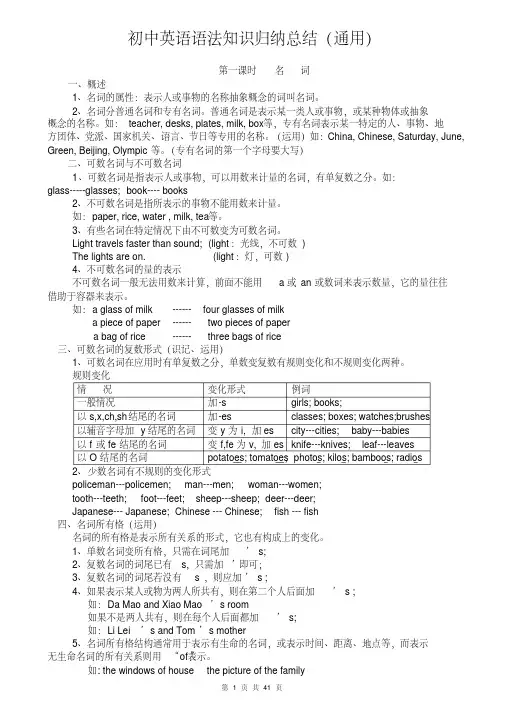
初中英语语法知识归纳总结(通用)第一课时名词一、概述1、名词的属性:表示人或事物的名称抽象概念的词叫名词。
2、名词分普通名词和专有名词。
普通名词是表示某一类人或事物,或某种物体或抽象概念的名称。
如:teacher, desks, plates, milk, box等,专有名词表示某一特定的人、事物、地方团体、党派、国家机关、语言、节日等专用的名称。
(运用)如:China, Chinese, Saturday, June, Green, Beijing, Olympic等。
(专有名词的第一个字母要大写)二、可数名词与不可数名词1、可数名词是指表示人或事物,可以用数来计量的名词,有单复数之分。
如:glass-----glasses; book---- books2、不可数名词是指所表示的事物不能用数来计量。
如:paper, rice, water , milk, tea等。
3、有些名词在特定情况下由不可数变为可数名词。
Light travels faster than sound; (light:光线,不可数)The lights are on. (light:灯,可数)4、不可数名词的量的表示不可数名词一般无法用数来计算,前面不能用a或an或数词来表示数量,它的量往往借助于容器来表示。
如:a glass of milk ------ four glasses of milka piece of paper ------ two pieces of papera bag of rice ------ three bags of rice三、可数名词的复数形式(识记、运用)1、可数名词在应用时有单复数之分,单数变复数有规则变化和不规则变化两种。
规则变化情况变化形式例词一般情况加-s girls; books;以s,x,ch,sh结尾的名词加-es classes; boxes; watches;brushes以辅音字母加y结尾的名词变y为i, 加es city---cities; baby---babies以f或fe结尾的名词变f,fe为v, 加es knife---knives; leaf---leaves以O结尾的名词potatoes; tomatoes;photos; kilos; bamboos; radios2、少数名词有不规则的变化形式policeman---policemen; man---men; woman---women;tooth---teeth; foot---feet; sheep---sheep; deer---deer;Japanese--- Japanese; Chinese --- Chinese; fish --- fish四、名词所有格(运用)名词的所有格是表示所有关系的形式,它也有构成上的变化。
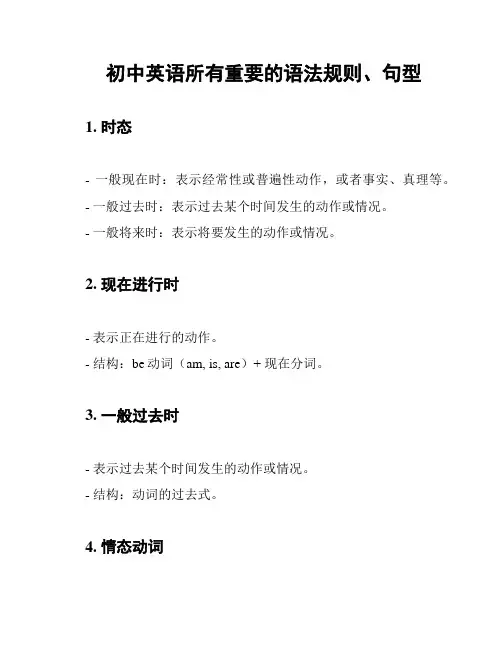
初中英语所有重要的语法规则、句型
1. 时态
- 一般现在时:表示经常性或普遍性动作,或者事实、真理等。
- 一般过去时:表示过去某个时间发生的动作或情况。
- 一般将来时:表示将要发生的动作或情况。
2. 现在进行时
- 表示正在进行的动作。
- 结构:be动词(am, is, are)+ 现在分词。
3. 一般过去时
- 表示过去某个时间发生的动作或情况。
- 结构:动词的过去式。
4. 情态动词
- 表示能力、可能性、必要性等。
- 常见的情态动词有:can, could, may, might, must, will, would, should。
5. 被动语态
- 表示动作的承受者在句中作主语。
- 结构:be动词 + 过去分词。
6. 感叹句
- 用来表达惊讶、赞美、喜悦等强烈感情。
- 结构:How + adj./adv. + 主语 + 动词!
7. 条件句
- 表示某种条件下可能发生的情况。
- 结构:if + 条件从句,主句。
8. 祈使句
- 用于表示命令、请求、建议等。
- 结构:动词原形 + ...
9. 疑问句
- 用于提问。
- 一般疑问句结构:助动词/情态动词 + 主语 + 动词原形?
10. 介词
- 用于表示关系、位置、方向等。
- 常见的介词有:in, on, at, for, with, to, from, before, after, etc.
以上是初中英语中的一些重要的语法规则和句型,希望对你有帮助!。
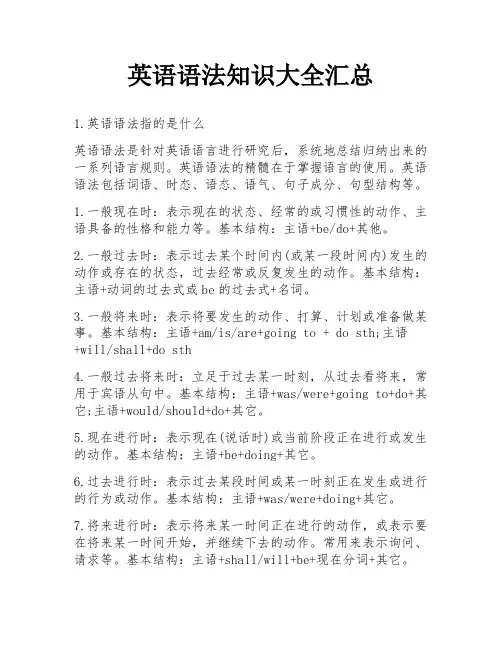
英语语法知识大全汇总1.英语语法指的是什么英语语法是针对英语语言进行研究后,系统地总结归纳出来的一系列语言规则。
英语语法的精髓在于掌握语言的使用。
英语语法包括词语、时态、语态、语气、句子成分、句型结构等。
1.一般现在时:表示现在的状态、经常的或习惯性的动作、主语具备的性格和能力等。
基本结构:主语+be/do+其他。
2.一般过去时:表示过去某个时间内(或某一段时间内)发生的动作或存在的状态,过去经常或反复发生的动作。
基本结构:主语+动词的过去式或be的过去式+名词。
3.一般将来时:表示将要发生的动作、打算、计划或准备做某事。
基本结构:主语+am/is/are+going to + do sth;主语+will/shall+do sth4.一般过去将来时:立足于过去某一时刻,从过去看将来,常用于宾语从句中。
基本结构:主语+was/were+going to+do+其它;主语+would/should+do+其它。
5.现在进行时:表示现在(说话时)或当前阶段正在进行或发生的动作。
基本结构:主语+be+doing+其它。
6.过去进行时:表示过去某段时间或某一时刻正在发生或进行的行为或动作。
基本结构:主语+was/were+doing+其它。
7.将来进行时:表示将来某一时间正在进行的动作,或表示要在将来某一时间开始,并继续下去的动作。
常用来表示询问、请求等。
基本结构:主语+shall/will+be+现在分词+其它。
8.过去将来进行时:表示就过去某一时间而言,将来某一时刻或某一段时间正在进行的动作,主要用于宾语从句中,尤其多用于间接引语中。
基本结构:should/would+be+现在分词。
9.现在完成时:过去发生或已经完成的动作对现在造成的影响或结果,或从过去已经开始,持续到现在的动作或状态。
基本结构:主语+have/has+p.p(过去分词)+其它。
10.过去完成时:以过去某个时间为标准,在此以前发生的动作或行为,或在过去某动作之前完成的行为,即“过去的过去”。
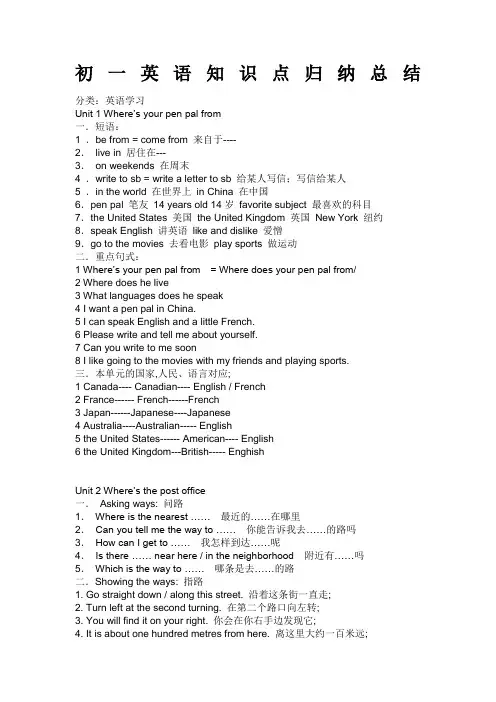
初一英语知识点归纳总结分类:英语学习Unit 1 Where’s your pen pal from一.短语:1 .be from = come from 来自于----2.live in 居住在---3.on weekends 在周末4 .write to sb = write a letter to sb 给某人写信;写信给某人5 .in the world 在世界上in China 在中国6.pen pal 笔友14 years old 14岁favorite subject 最喜欢的科目7.the United States 美国the United Kingdom 英国New York 纽约8.speak English 讲英语like and dislike 爱憎9.go to the movies 去看电影play sports 做运动二.重点句式:1 Where’s your pen pal from = Where does your pen pal from/2 Where does he live3 What languages does he speak4 I want a pen pal in China.5 I can speak English and a little French.6 Please write and tell me about yourself.7 Can you write to me soon8 I like going to the movies with my friends and playing sports.三.本单元的国家,人民、语言对应;1 Canada---- Canadian---- English / French2 France------ French------French3 Japan------Japanese----Japanese4 Australia----Australian----- English5 the United States------ American---- English6 the United Kingdom---British----- EnghishU nit 2 Where’s the post office一.Asking ways: 问路1.Where is the nearest …… 最近的……在哪里2.Can you tell me the way to …… 你能告诉我去……的路吗3.How can I get to …… 我怎样到达……呢4.Is there …… near here / in the neighborhood 附近有……吗5.Which is the way to ……哪条是去……的路二.Showing the ways: 指路1. Go straight down / along this street. 沿着这条街一直走;2. Turn left at the second turning. 在第二个路口向左转;3. You will find it on your right. 你会在你右手边发现它;4. It is about one hundred metres from here. 离这里大约一百米远;5. You’d bette r take a bus. 你最好坐公交车去;You’d better+动词原形三.词组1. across from …… 在……的对面across from the bank 在银行的对面2. next to…… 紧靠…… next to the supermarket 紧靠超市3. between……and…… 在……和……之间between the park and the zoo 在公园和动物园之间among 表示位于三者或三者以上之间4. in front of…… 在……前面There is a tree in front of the classroom.课室前面有棵树;in the front of…… 在……内的前部There is a desk in the front of the classroom.课室内的前部有张桌子;5. behind…… 在……后面behind my house 在我家后面6. turn left/ right 向左/右拐on the left/right of…… 在某物的左/右边on the left of our school 在我们学校的左边on one’s left/right 在某人的左/右边on my left 在我左边7. go straight 一直走8. down /along…… 沿着……街道down/along Center Street 沿着中央街9. in the neighborhood=near here 在附近10 welcome to…… 欢迎来到……11. take /have a walk 散步12. the beginning o f…… ……的开始,前端at the beginning of…… 在……的开始,前端in the beginning 起初,一开始13. have fun=have a good time=enjoy oneself 玩得开心,过得愉快我昨天玩得很开心; I had fun yesterday.I had a good time yesterday.I enjoyed myself yesterday.14. have a good trip 旅途愉快15. take a taxi 坐出租车16. 到达:get to +地方get here/ there/ home 到这/那/家arrive in +大地方I arrive in Beijing.arrive at +小地方I arrive at the bank.reach +地方17.go across 从物体表面横过go across the street 横过马路go through 从空间穿过go through the forest 穿过树林18.on + 街道的名称; Eg: on Center Streetat + 具体门牌号+街道的名称Eg: at 6 Center Street三.重难点解析1.enjoy doing sth 享受做某事的乐趣,喜爱做某事I enjoy reading. 我喜爱读书;到目前为止,我们学了两个特殊的动词finish和enjoy,都是要带doing.I finish cleaning the room. 我扫完了这间屋子;2.hope to do sth 希望做某事I hope to pass this exam. 我希望通过这次考试; hope +从句I hope tomorrow will be fine. 我希望明天将会晴朗;从句即是一个小句子,这个小句子又放在大句子中,从属于大句子,所以叫从句;如tomorrow will be fine是一个从句,它又放在I hope 的后面,形成句中有句;3. if 引导一个表示假设的句子;If I have much money, I will go to the moon. 如果我有许多钱,我就会去月球;If you are hungry, you can buy some food in the supermarket.如果你饿了的话,你可以在超市买一些食物;四.本单元的反义词、近义词配对1new—old 2 quiet--- busy 3 dirty--- clean 4 big---- smallUnit 3 Why do you like koala bears一.重点词组eat grass eat leaves be quiet very shy very smart very cuteplay with her friends kind of South Africa other animalsat night in the day every day during the day二. 交际用语1. Why do you like pandas Because they’re very clever.2. Why does he like koalas Because they’re kind of interesting.3. Where are lions from They are from South Africa.4. What other animals do you likeI like dogs, too.WhyBecause they’re friendly and clever.5. Molly likes to play with her friends and eat grass.6. She’s very shy.7. He is from Australia.8.He sleeps during the day, but at night he gets up and eats leaves.9.He usually sleeps and relaxes 20 hours every day.10.Let’s see the pandas first.11.They’re kind of interesting.12.What other animals do you like13.Why do you want to see the lions三. 重点难点释义1、kind of 有点,稍微Koala bears are kind of shy. 考拉有点害羞;kind 还有“种类”的意思如:各种各样的all kinds ofWe have all kinds of beautiful flowers in our school.2、China n. 中国Africa n. 非洲China 和Africa都是专有名词,首字母都应该大写,而且和介词in连用;There are many kinds of tigers in China.There are many kinds of scary animals in Africa.3、friendly adj. 友好的,和蔼可亲的它是名词friend的形容词形式,常常和be动词连用, be friendly;The people in Chengdu are very friendly.4、with prep. 跟,同,和…在一起I usually play chess with my father.注意区别与and的用法,and通常用于连接主语或宾语,连接主语时,如果有I, I通常放在and 之后,如:My father and I usually play chess together.Play with “和…一起玩耍”“玩…”I often play with my pet dog.Don’t play with water5、day和night 是一对反义词,day 表示白天或一天,night表示夜或夜晚;通常说in the day, during the day, at night;Koala bears often sleep during the day and eat leaves at night.6、leaf n. 叶子复数形式为:leaves, 类似的变化还有:wife—wives, wolf—wolves, knife—knives等;7、hour n. 小时;点钟hour前边通常加上冠词an 表示“一个小时”, 即:an hour;There are 24 hours in a day and 60minutes in an hour.8、be from 来自…be from = come fromPandas are from China. = Pandas come form China.9、meat n. 食用的肉,为不可数名词,表示“许多”时,使用much来修饰,即:much meatHe eats much meat every day.10、grass n. 草,为不可数名词,表示“许多”时,使用much来修饰,即:much grass; There is much grass on the playground.四. 语法知识特殊疑问句通常以“what”、“who”、“which”、“when”、“where”、“how”、“how old”、“how many”等开头,对某一具体问题进行提问;特殊疑问句的基本构成有两种情况:1. 疑问句+一般疑问句结构;这是最常见的情况;例如:What’s your grandfather’s telephone number 你爷爷的号码是多少Who is that boy with big eyes 那个大眼睛的男孩是谁Which season do you like best 你最喜欢哪个季节When is he going to play the piano 他什么时候弹钢琴Where does he live 他住在哪儿How are you 你好吗How old are you 你多大了How many brothers and sisters do you have 你有几个兄弟姐妹2. 疑问句+陈述句结构;这时疑问词作主语或修饰主语;例如:Who is on duty today今天谁值日Which man is your teacher哪位男士是你的老师我们学过的What/How about+名词/代词+其他也是特殊疑问句,它是一种省略结构;例如:I like English. What/How about you 我喜欢英语;你呢What about playing basketball 打篮球怎么样Unit 4 I want to be an actor.一.短语:1 want to do sth 想要作某事2 give sb sth = give sth to sb 给某人某物/ 把某物给某人3 help sb do sth 帮助某人作某事Eg: I want to help my mother do some housework at home.4 help sb with sth 帮助某人谋事Eg: I want to help my mother with some housework at home5 in the day 在白天6 at night 在晚上7 talk with/ to sb 和----谈话8 be busy doing sth 忙于做某事Eg: He is busy listening to the teacher.9 in a hospital 在医院l10 work/ study hard 努力工作11 Evening Newspaper 晚报二.重点句式及注意事项:1 询问职业的特殊疑问词是what;有三种主要句式①What + is / are + sb②What + does/ do + sb + do③What + is/ are + 名词所有格/ 形容词性物主代词+ job2 People give me their money or get their money from me.3 Sometimes I work in the day and sometimes at night.4 I like talking to people.5 I work late. I’m very busy when people go out to dinners.6 Where does your sister work7 then we have a job for you as a waiter.8 Do you want to work for a magazine Then come and work for us as a reporter.9 Do you like to work evenings and weekends10 We are an international school for children of 5-12.三.本单元中的名词复数;1 policeman--- policemen2 woman doctor----- women doctors 3thief-----thieves首先主谓宾结构I have an apple.其次定状补I really have a big apple.really做have的状语状语修饰动词动词一般就是谓语动词big做apple的定语定语修饰名词名词一般是主语或宾语最后主系表结构它与主谓宾很相似只不过谓语动词时系动词最常见的是be动词及其变形I am a student;主语通常用于句子开端,主要有:i,you,he,she,it,we,they,但it有时用作形式主语,表特指;谓语,通常放在主语之后,一般是动词,表示“某某人在;;;”宾语,通常放在谓语之后,一般是主语的宾格;有时候是人,有时候是物;定语,状语,通常是从句;定语从句:常有关系代词that\which\who\whoes,关系副词when\where\why.通常选择关系词的步骤是:1、确定先行词2.确定关系词.主系表:主,就是主语;系,特指系动词,就是说当句子中没有谓语时,用系动词来代替;表,修饰系动词用;1、名词A、名词的数我们知道名词可以分为可数名词和不可数名词,而不可数名词它没有复数形式,但可数名词却有单数和复数之分,复数的构成如下:一在后面加s;如:fathers, books, Americans, Germans, apples, bananas二x, sh, ch, s, tch后加es;如:boxes, glasses, dresses, watches, wishes, faxes三1以辅音字母加y结尾的变y为i再加es 如:baby-babies, family-families, duty-duties, comedy-comedies, documentary-documentaries, story-stories2以元音字母加y结尾的直接加s;如:day-days, boy-boys, toy-toys, key-keys, ways四以o结尾加s外来词;如:radios, photos, 但如是辅音加o的加es:如: tomatoes 西红柿, potatoes马铃薯五以f或fe结尾的变f为v再加ess;如:knife-knives, wife-wives, half-halves, shelf-shelves, leaf-leaves, yourself-yourselves六单复数相同不变的有:fish, sheep, deer鹿子, Chinese, Japanese七一般只有复数,没有单数的有:people,pants, shorts, shoes, glasses, gloves, clothes, socks八单词形式不变,既可以是单数也可以是复数的有:police警察局,警察, class班,同学, family家,家庭成员九合成的复数一般只加主要名词,多数为后一个单词;如:action movie-action movies, pen pal-pen pals; 但如果是由man或woman所组成的合成词的复数则同时为复数;如:man doctor-men doctors, woman teacher-women teachers十有的单复数意思不同;如:fish鱼fishes鱼的种类, paper纸papers报纸,卷子,论文, work工作works作品,工厂, glass玻璃glasses玻璃杯,眼镜, orange桔子水oranges橙子, light光线lights灯, people人peoples民族, time时间times 时代, 次数, chicken 鸡肉chickens 小鸡十一单个字母的复数可以有两种形式直接加s或’s;如:Is I’s, Ks K’s;但如是缩略词则只加s;如:IDs, VCDs, SARs十二特殊形式的有:child-children, man-men, woman-women, foot-feet, mouse-mice, policeman-policemen, Englishman-EnglishmenB名词的格当我们要表示某人的什么东西或人时,我们就要使用所有格形式;构成如下:一单数在后面加’s;如:brother’s, Mike’s, teacher’s二复数以s结尾的直接在s后加’,如果不是以s结尾的与单数一样处理;如:Teachers’ Day教师节, classmates’; Children’s Day六一节, Women’s Day三八节三由and并列的名词所有时,如果是共同所有同一人或物时,只加最后一个’s,但分别拥有时却分别按单数形式处理;如:Mike and Ben’s room迈克和本的房间共住一间,Mike’s and Ben’s rooms迈克和本的房间各自的房间2、代词项目人称代词物主代词指示代词反身代词人称主格宾格形容词名词性第一人称单数I me my mine myself复数we us our ours ourselves第二人称单数you you your yours yourself复数you you your yours yourselves第三人称单数she her her hers herselfhe him his his himselfit it its its this that itself复数they them their theirs these those themselves3、动词A 第三人称单数当动词是第三人称单数时,动词应该像名词的单数变动词那样加s,如下:一一般在词后加s;如:comes, spells, waits, talks, sees, dances, trains二在x, sh, ch, s, tch后加es;如:watches, washes, wishes, finishes三1以辅音字母加y结尾的变y为i再加es;如:study-studies, hurry-hurries, try-tries2以元音字母加y结尾的直接加s;如:plays, says, stays, enjoys, buys四以o结尾加es;如:does, goes五特殊的有:are-is, have-hasB 现在分词当我们说某人正在做什么事时,动词要使用分词形式,不能用原形,构成如下:一一般在后加ing;如:spell-spelling, sing-singing, see-seeing, train-training, play-playing, hurry-hurrying, watch-watching, go-going, do-doing二以不发音e的结尾的去掉e再加ing;如:dance-dancing, wake-waking,take-taking, practice-practicing, write-writing, have-having三以重读闭音节结尾且一个元音字母+一个辅音字母注意除开字母组合如show –showing, draw-drawing要双写最后的辅音字母再加ing;如:put-putting,run-running, get-getting, let-letting, begin-beginning四以ie结尾的变ie为y再加ing;如:tie-tying系die-dying死lie-lying 位于4、形容词的级我们在对两个或以上的人或物进行对比时,则要使用比较或最高级形式;构成如下:一一般在词后加er或est如果是以e结尾则直接加r或st;如:greater-greatest, shorter –shortest, taller –tallest, longer –longest, nicer- nicest, larger -largest二以重读闭音节结尾且1个元音字母+1个辅音字母字母组合除外,如few-fewer fewest结尾的双写结尾的辅音再加er /est;如:big-bigger biggest, red-redder reddest, hot-hotter hottest三以辅音字母+y结尾的变y为i加er/est;如:happy-happier happiest,sorry-sorrier sorriest, friendly-friendlier friendliestmore friendly most friendly, busy-busier busiest, easy-easier easiest四特殊情况:两好多坏,一少老远good/well - better best many/much - more most bad/ill – worse worstlittle- less least old- older/elder oldest/eldest far- farther/further farthest/furthest 5、数词基变序,有规则;一、二、三,自己背;五、八、九、十二;其它后接th;y结尾,变为i, eth跟上去; first, second, third; fifth, eighth, ninth, twelfth; seventh, tenth, thirteenth, hundredth; twenty-twentieth, forty-fortieth, ninety-ninetieth二、初一英语语法——句式1.陈述句肯定陈述句a This is a book. be动词b He looks very young. 连系动词c I want a sweat like this. 实义动词d I can bring some things to school. 情态动词e There’s a computer on my desk. There be结构否定陈述句a These aren’t their books. b They don’t look nice.c Kate doesn’t go to No. 4 Middle School.d Kate can’t find her doll.e There isn’t a cat here. =There’s no cat here.2. 祈使句肯定祈使句a Please go and ask the man. b Let’s learn Englishc Come in, please.否定祈使句a Don’t be late. b Don’t hu rry.3. 疑问句1 一般疑问句a Is Jim a student b Can I help you c Does she like saladd Do they watch TVe Is she reading肯定回答: a Yes, he is. b Yes, you can. c Yes, she does. d Yes, they do. e Yes, she is.否定回答: a No, he isn’t. b No, you can’t. c No, she doesn’t. d No, they don’t. e No, she isn’t.2 选择疑问句Is the table big or small 回答It’s big./ It’s small.3 特殊疑问句①问年龄How old is Lucy She is twelve.②问种类What kind of movies do you like I like action movies and comedies.③问身体状况How is your uncle He is well/fine.④问方式How do/can you spell it L-double O-K.How do we contact you My e-mail address is cindyjones163.⑤问原因Why do you want to join the club⑥问时间What’s the time =What time is it It’s a quarter to ten a.m..What time do you us ually get up, Rick At five o’clock.When do you want to go Let’s go at 7:00.⑦问地方Where’s my backpack It’s under the table.⑧问颜色What color are they They are light blue.What’s your favourite color It’s black.⑨问人物Who’s that It’s my sister.Who is the boy in blue My brother.Who isn’t at school Peter and Emma.Who are Lisa and Tim talking to⑩问东西What’s this/that in English It’s a pencil case.What else can you see in the picture I can see some broccoli, strawberries and hamburgers.11问姓名What’s your aunt’s name Her name is Helen./She’s Helen. What’s your first name My first name’s Ben.What’s your family name My family name’s Smith.12 问哪一个Which do you like I like one in the box.13 问字母What letter is it It’s big D/small f.14 问价格How much are these pants They’re 15 dollars.15 问号码What’s your phone number It’s 576-8349.16 问谓语动作What’s he doing He’s watching TV.17 问职业身份 What do you do What’s your father He’s a doctor.句子结构1.S主+ Vi不及物动词谓Time flies.1 S + V + adverbial状语Birds sing beautifully.2 S + Vi+ prep Phrase介词短语He went on holiday.3 S + Vi+ Infinitive 不定式We stopped to have a rest.4 S + Vi+ Participle 分词I'll go swimming.2. S 主+ Vt 及物动词谓+ O宾We like English.1 S + VT + N/PronI like music.I like her.2 S + VT + infinitive不定式I want to help him.常用于这句型的动词有:attempt, dare, decide, desire, expect, hope, intend, learn, need, offer, pretend, promise, propose, purpose, refuse, want, wish等;3 S + VT + Wh-Word + InfinitiveI don't know what to do.常用于这句型的动词有:ask, consider, decide, discover, explain, find out, forget, guess, inquire, know, learn, observe, remember, see, settle, tell, think, understand, wonder等;4 S + VT + GerundI enjoy living here.常用于这句型的动词有:admit, advise, avoid, consider, defend, enjoy, excuse, finish, forbid, mind, miss, practise, risk, suggest, give up, can't help等;5 S + VT + That-clauseI don't think that he is right.常用于这句型的动词有:Admit, believe, command, confess, declare, demand, deny, doubt, expect, explain, feel觉得, hear听说, hope, imagine, intend, know, mean, mind当心, notice, propose, request, report, say, see看出,show, suggest, suppose, think, understand, wish, wonder觉得奇怪;3. S 主+ V谓lv 系动词+ P表We are Chinese.除了be 系动词外,还有一些动词也可以用作系动词,1表感官的动词,feel, smell, taste, sound, look, appear, seem 等;2 表转变变化的动词,become, get, grow, turn, go,等; 3表延续的动词remain, keep, seem, hold, stay, rest等;4表瞬时的动词come, fall, set, cut, occur等5其他动词eat, lie, prove, ring, run, shine, sit, stand, continue, hang等;1 S + Lv + N/Pron名词/代词He is a boy.This is mine.2 S + Lv + Adj形容词She is beautiful.3 S + Lv + Adv 副词Class is over.4 S + Lv + Prep PhraseHe is in good health.5 S + Lv + Participle分词He is excited.The film is interesting.4. S 主+ VT 谓+ In O间接宾+ D O直接宾I give you help.1 S + VT + N/Pron + NI sent him a book.I bought May a book.2 S + VT + N/Pron + To/for-phraseHe sent a book to me.He bought a coat for me.间接宾语前需要加to 的常用动词有:allow, bring, deny, do带来, give, grant, hand, leave, lend, offer, owe, pass, pay, permit, promise, read, refuse, render, restore, sell, send, show, teach, tell wish, write等;间接宾语前需要加for 的常用动词有:bring, buy, cash, choose, fetch, get, leave, make, order, paint, play演奏,save, sing, spare等;5. S 主+ VT谓+ O宾+ O C宾补I make you clear.1 S + VT + N/Pron + NWe named our baby Tom.常用于这句型的动词有:appoint, call, choose, elect, entitle, find, make, name, nominate命名;2 S + VT + N/Pron + AdjHe painted the wall white.常用于这句型的动词有:beat, boil, cut, drive, find, get, hold, keep, leave, like, make, paint, see, set, turn, want, wash, wipe, wish等;3 S + VT + N/Pron + Prep PhraseShe always keeps everything in good order.4 S + VT + N/Pron + InfinitiveI wish you to stay.I made him work常用于这句型的动词有:a不定式带to的词:advice, allow, ask, beg, cause, choose, command, decide, encourage, expect, force, get, hate, invite, know, leave, like, love, order, permit, persuade, prefer, remain, request, teach, tell, want, warn, wish等;b不定式不带to的词:feel, have, hear, know, let, listen to, look at, make, notice, see, watch等;5 S + VT + N/Pron + Participle 分词I heard my name called.I feel something moving.常用于这句型的动词有:catch, feel, find, get, have, hear, imagine, keep, leave, listen to, look at, notice, observe, perceive, see, set, smell, start, watch等;6 S + VT + N/Pron + Wh-word + InfinitiveHe show me how to do it.常用于这句型的动词有:advise, ask, inform, show, teach, tell等;7 S + VT + N/Pron + That-clauseHe told me that the film was great.常用于这句型的动词有:assure, inform, promise, remind, teach, tell, warm等;8 S + VT + N/Pron + Wh-ClauseHe asked me what he should do.常用于这句型的动词有:Advise, ask, inform, show, teach, tell.三、初一英语语法——时态1、一般现在时表示普遍、经常性的或长期性的动作时使用一般现在时,它有:Be 动词:She’s a worker. Is she a worker She isn’t a worker.情态动词:I can play the piano. Can you play the piano I ca n’t play the piano.行为动词:They want to eat some tomatoes. Do they want to eat any tomatoes They don’t want to eat any tomatoes.Gina has a nice watch. Does Gina have a nice watch Gina doesn’t have a watch.2、现在进行时表示动词在此时正在发生或进行就使用进行时态,结构为sb be v-ing sth + 其它.I’m playing baseball. Are you playing baseball I’m not playing baseball. Nancy is writing a letter. Is Nancy writing a letter Nancy isn’t writing a letter.They’re listening to the pop music. Are they listening the pop music They aren’t list ening to the pop music.一.短语:1 .be from = come from 来自于----2.live in 居住在---3.on weekends 在周末4 .write to sb = write a letter to sb 给某人写信;写信给某人5 .in the world 在世界上in China 在中国6.pen pal 笔友14 years old 14岁favorite subject 最喜欢的科目7.the United States 美国the United Kingdom 英国New York 纽约8.speak English 讲英语like and dislike 爱憎9.go to the movies 去看电影play sports 做运动二.重点句式:1 Where’s your pen pal from = Where does your pen pal from/2 Where does he live3 What languages does he speak4 I want a pen pal in China.5 I can speak English and a little French.6 Please write and tell me about yourself.7 Can you write to me soon8 I like going to the movies with my friends and playing sports.三.本单元的国家,人民、语言对应;1 Canada---- Canadian---- English / French2 France------ French------French3 Japan------Japanese----Japanese4 Australia----Australian----- English5 the United States------ American---- English6 the United Kingdom---British----- EnghishUnit 2 Where’s the post office一.Asking ways: 问路1.Where is the nearest …… 最近的……在哪里2.Can you tell me the way to …… 你能告诉我去……的路吗3.How can I get to …… 我怎样到达……呢4.Is there …… near here / in the neighborhood 附近有……吗5.Which is the way to …… 哪条是去……的路二.Showing the ways: 指路1. Go straight down / along this street. 沿着这条街一直走;2. Turn left at the second turning. 在第二个路口向左转;3. You will find it on your right. 你会在你右手边发现它;4. It is about one hundred metres from here. 离这里大约一百米远;5. You’d better take a bus. 你最好坐公交车去;You’d better+动词原形三.词组1. across from …… 在……的对面across from the bank 在银行的对面2. next to…… 紧靠…… next to the supermarket 紧靠超市3. between……and…… 在……和……之间between the park and the zoo 在公园和动物园之间among 表示位于三者或三者以上之间4. in front of…… 在……前面There is a tree in front of the classroom.课室前面有棵树;in the front of…… 在……内的前部There is a desk in the front of the classroom.课室内的前部有张桌子;5. behind…… 在……后面behind my house 在我家后面6. turn left/ right 向左/右拐on the left/right of…… 在某物的左/右边on the left of our school 在我们学校的左边on one’s left/right 在某人的左/右边on my left 在我左边7. go straight 一直走8. down /along…… 沿着……街道down/along Center Street 沿着中央街9. in the neighborhood=near here 在附近10 welcome to…… 欢迎来到……11. take /have a walk 散步12. the beginning of…… ……的开始,前端at the beginning of…… 在……的开始,前端in the beginning 起初,一开始13. have fun=have a good time=enjoy oneself 玩得开心,过得愉快我昨天玩得很开心; I had fun yesterday.I had a good time yesterday.I enjoyed myself yesterday.14. have a good trip 旅途愉快15. take a taxi 坐出租车16. 到达:get to +地方get here/ there/ home 到这/那/家arrive in +大地方I arrive in Beijing.arrive at +小地方I arrive at the bank.reach +地方17.go across 从物体表面横过go across the street 横过马路go through 从空间穿过go through the forest 穿过树林18.on + 街道的名称; Eg: on Center Streetat + 具体门牌号+街道的名称Eg: at 6 Center Street三.重难点解析1.enjoy doing sth 享受做某事的乐趣,喜爱做某事I enjoy reading. 我喜爱读书;到目前为止,我们学了两个特殊的动词finish和enjoy,都是要带doing.I finish cleaning the room. 我扫完了这间屋子;2.hope to do sth 希望做某事I hope to pass this exam. 我希望通过这次考试; hope +从句I hope tomorrow will be fine. 我希望明天将会晴朗;从句即是一个小句子,这个小句子又放在大句子中,从属于大句子,所以叫从句;如tomorrow will be fine是一个从句,它又放在I hope 的后面,形成句中有句;3. if 引导一个表示假设的句子;If I have much money, I will go to the moon. 如果我有许多钱,我就会去月球; If you are hungry, you can buy some food in the supermarket.如果你饿了的话,你可以在超市买一些食物;四.本单元的反义词、近义词配对1new—old 2 quiet--- busy 3 dirty--- clean 4 big---- smallUnit 3 Why do you like koala bears一.重点词组eat grass eat leaves be quiet very shy very smart very cuteplay with her friends kind of South Africa other animalsat night in the day every day during the day二. 交际用语1. Why do you like pan das Because they’re very clever.2. Why does he like koalas Because they’re kind of interesting.3. Where are lions from They are from South Africa.4. What other animals do you likeI like dogs, too.WhyBecause they’re friendly and clever.5. Molly likes to play with her friends and eat grass.6. She’s very shy.7. He is from Australia.8.He sleeps during the day, but at night he gets up and eats leaves. 9.He usually sleeps and relaxes 20 hours every day.10.Let’s see the pandas first.11.They’re kin d of interesting.12.What other animals do you like13.Why do you want to see the lions三. 重点难点释义1、kind of 有点,稍微Koala bears are kind of shy. 考拉有点害羞;kind 还有“种类”的意思如:各种各样的all kinds ofWe have all kinds of beautiful flowers in our school.2、China n. 中国Africa n. 非洲China 和Africa都是专有名词,首字母都应该大写,而且和介词in连用;There are many kinds of tigers in China.There are many kinds of scary animals in Africa.3、friendly adj. 友好的,和蔼可亲的它是名词friend的形容词形式,常常和be动词连用, be friendly;The people in Chengdu are very friendly.4、with prep. 跟,同,和…在一起I usually play chess with my father.注意区别与and的用法,and通常用于连接主语或宾语,连接主语时,如果有I, I通常放在and 之后,如:My father and I usually play chess together.Play with “和…一起玩耍”“玩…”I often play with my pet dog.Don’t play with water5、day和night 是一对反义词,day 表示白天或一天,night表示夜或夜晚;通常说in the day, during the day, at night;Koala bears often sleep during the day and eat leaves at night.6、leaf n. 叶子复数形式为:leaves, 类似的变化还有:wife—wives, wolf—wolves, knife—knives等;7、hour n. 小时;点钟hour前边通常加上冠词an 表示“一个小时”, 即:an hour;There are 24 hours in a day and 60minutes in an hour.8、be from 来自…be from = come fromPandas are from China. = Pandas come form China.9、meat n. 食用的肉,为不可数名词,表示“许多”时,使用much来修饰,即:much meatHe eats much meat every day.10、grass n. 草,为不可数名词,表示“许多”时,使用much来修饰,即:much grass; There is much grass on the playground.四. 语法知识特殊疑问句通常以“what”、“who”、“which”、“when”、“where”、“how”、“how old”、“how many”等开头,对某一具体问题进行提问;特殊疑问句的基本构成有两种情况:1. 疑问句+一般疑问句结构;这是最常见的情况;例如:What’s your grandfather’s telephone number 你爷爷的号码是多少Who is that boy with big eyes 那个大眼睛的男孩是谁Which season do you like best 你最喜欢哪个季节When is he going to play the piano 他什么时候弹钢琴Where does he live 他住在哪儿How are you 你好吗How old are you 你多大了How many brothers and sisters do you have 你有几个兄弟姐妹2. 疑问句+陈述句结构;这时疑问词作主语或修饰主语;例如:Who is on duty today今天谁值日Which man is your teacher哪位男士是你的老师我们学过的What/How about+名词/代词+其他也是特殊疑问句,它是一种省略结构;例如:I like English. What/How about you 我喜欢英语;你呢What about playing basketball 打篮球怎么样Unit 4 I want to be an actor.一.短语:1 want to do sth 想要作某事2 give sb sth = give sth to sb 给某人某物/ 把某物给某人3 help sb do sth 帮助某人作某事Eg: I want to help my mother do some housework at home.4 help sb with sth 帮助某人谋事Eg: I want to help my mother with some housework at home5 in the day 在白天6 at night 在晚上7 talk with/ to sb 和----谈话8 be busy doing sth 忙于做某事Eg: He is busy listening to the teacher.9 in a hospital 在医院l10 work/ study hard 努力工作11 Evening Newspaper 晚报二.重点句式及注意事项:1 询问职业的特殊疑问词是what;有三种主要句式①What + is / are + sb②What + does/ do + sb + do③What + is/ are + 名词所有格/ 形容词性物主代词+ job2 People give me their money or get their money from me.3 Sometimes I work in the day and sometimes at night.4 I like talking to people.5 I work late. I’m very busy when people go out to dinners.6 Where does your sister work7 then we have a job for you as a waiter.8 Do you want to work for a magazine Then come and work for us as a reporter.9 Do you like to work evenings and weekends10 We are an international school for children of 5-12.三.本单元中的名词复数;。
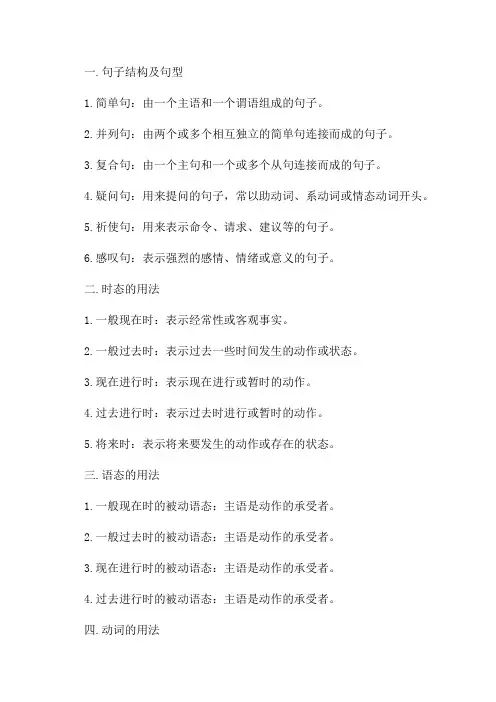
一.句子结构及句型1.简单句:由一个主语和一个谓语组成的句子。
2.并列句:由两个或多个相互独立的简单句连接而成的句子。
3.复合句:由一个主句和一个或多个从句连接而成的句子。
4.疑问句:用来提问的句子,常以助动词、系动词或情态动词开头。
5.祈使句:用来表示命令、请求、建议等的句子。
6.感叹句:表示强烈的感情、情绪或意义的句子。
二.时态的用法1.一般现在时:表示经常性或客观事实。
2.一般过去时:表示过去一些时间发生的动作或状态。
3.现在进行时:表示现在进行或暂时的动作。
4.过去进行时:表示过去时进行或暂时的动作。
5.将来时:表示将来要发生的动作或存在的状态。
三.语态的用法1.一般现在时的被动语态:主语是动作的承受者。
2.一般过去时的被动语态:主语是动作的承受者。
3.现在进行时的被动语态:主语是动作的承受者。
4.过去进行时的被动语态:主语是动作的承受者。
四.动词的用法1.及物动词:必须接宾语才能构成完整的意思。
2.不及物动词:不需要接宾语就能构成完整的意思。
3.能愿动词:包括情态动词和行为动词,用于表示能力、愿望、可能性等。
五.名词的用法1.可数名词:表示可以数的事物或物体。
2.不可数名词:表示不可数的抽象概念、物质或一类事物。
3.可数名词的数量表示:使用具体数字、数词、不定代词等。
六.代词的用法1.主格代词:在句子中作主语或表语。
2.宾格代词:在句子中作宾语或介词宾语。
3.物主代词:表示所有关系,用来修饰名词。
4.反身代词:表示动作反映到自己身上。
七.形容词的用法1.表示性质或特征的词汇。
2.修饰名词或代词。
3.用比较级和最高级表示程度或比较。
八.副词的用法1.表示时间、地点、方式、程度等。
2.修饰动词、形容词、副词和句子。
九.介词的用法1.表示时间、地点、方式不同的介词。
2.用于修饰名词或代词。
十.连词的用法1. 并列连词:连接两个并列的分句,如and, but, or等。
2. 从属连词:连接主句和从句,如when, because, if等。
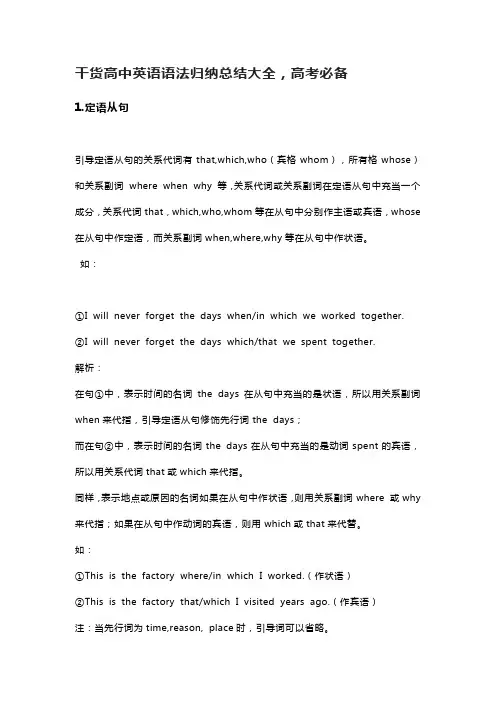
干货高中英语语法归纳总结大全,高考必备1.定语从句引导定语从句的关系代词有that,which,who(宾格whom),所有格whose)和关系副词where when why 等,关系代词或关系副词在定语从句中充当一个成分,关系代词that,which,who,whom等在从句中分别作主语或宾语,whose 在从句中作定语,而关系副词when,where,why等在从句中作状语。
如:①I will never forget the days when/in which we worked together.②I will never forget the days which/that we spent together.解析:在句①中,表示时间的名词the days在从句中充当的是状语,所以用关系副词when来代指,引导定语从句修饰先行词the days;而在句②中,表示时间的名词the days在从句中充当的是动词spent的宾语,所以用关系代词that或which来代指。
同样,表示地点或原因的名词如果在从句中作状语,则用关系副词where 或why 来代指;如果在从句中作动词的宾语,则用which或that来代替。
如:①This is the factory where/in which I worked.(作状语)②This is the factory that/which I visited years ago.(作宾语)注:当先行词为time,reason, place时,引导词可以省略。
①This was the first (when/what) I had serious trouble with my boss.②That is the reason (why) I did it.③This is the place (where) we met yesterday.另外,定语从句中谓语动词的数应与先行词的数相一致。

英语语法点归纳(8篇)学习英语最重要的就是掌握英语语法,那么你知道英语语法有哪些吗?下面是书包范文为大家分享的英语语法点归纳(8篇),希望能够给大家的写作带来一定的帮助。
连词的定义:连词是连接字、短语、从句与句子的词,是虚词,因此它不能独立担任句子成分。
连词主要分为两大类:并列连词和从属连词。
并列连词用来连接并列关系的词、词组或分句。
它包括:and,or,but,so,for,both…and,either…or,neither…nor,not only…but also。
从属连词用来引导从句,它包括: that, when, till, until,after, before, since,because,if,whether,though,although,so…that,so that,in order that,as soon as 并列连词用来连接具有并列关系的词,短语或句子。
常见的并列连词有:(1)表并列关系的and, both…and, not only…but also, neither…nor等。
(2)表选择关系的or, either…or等。
(3)表转折关系的but, while等。
(4)表因果关系的for, so等。
1并列连词 1 and:和,并且 Ilike basketball, football and table-tennis. 我喜欢篮球、足球和乒乓球。
1、基本用法 and表示“和”、“而且”的意思,用来连接对等关系的字和字,片语与片语,句子与句子。
He got up and put on his hat. 他站起来,戴上了帽子。
I went to the Summer Palace and he wentto Bei Hai Park. 我去颐和园,他去北海公园。
注意单词或词组如果是三个以上连接,一般在最后的单词或词组前加and。
另外“and”在译成中文时不一定要翻译出“和”来。
英语语法总结归纳英语语法总结归纳1、现在进行时Look, Listen是标志,现在进行正发生;有时now在句中现,“be+v-ing”时态成。
若问be用何形式,须看主语数、人称。
三单is我am,你和复数are紧随 (即:He / She is, I am. We, you,they 后are紧跟)。
v-ing形式更好记,三种构成要分清。
一般问句be提前,be后not否定成!2、一般现在时一般现在时态中,动词一般用原形。
表述事实讲真理,习惯动作常发生。
动词词尾加-s(es),只表单数三人称。
若变一般疑问句,得看句型是哪种。
系表结构和there be, be放句首即完成;若遇实义动词句,do或does莫忘记!3、一般过去时肯定句的过去式。
规则动词加ed,不规则的必须记。
否定形式疑问句,没有be加did。
如把did加在前,动词还要归原形。
4、基数词变序数词基变序,很容易,一二三,特殊记,th从四起。
八去t来九去e,遇到ve,f 替,ty变为tie,后加th莫迟疑,若想表示几十几,只变个位就可以。
5、时间介词巧记歌年、月、季节前用in,(如:in 2008, in September, in spring)日期前面行不通。
遇到几号或星期改用on来做代替, (如:on January 1,onWedesday)上午、下午、晚上仍用in。
(如:in the morning/afternoon/evening)若是某日上下午,也是用on才能行。
(如:on theevening of the Mid-autumn Day)正午、夜里用at, (如:at noon, at night)时、分用法也同理。
(如:, at two, at two)如若“差”点须加to, (如:two to two)如若“过”点改past。
(如:half past one)多说勤练牢牢记,学好英语非儿戏。
6、特殊的形容词、副词的比较级、最高级一分为二是三个, (指同一个形容词原形但是有两种比较级和最高级形式)两个“远”“来”一个“老”。
初中英语语法大全归纳总结一、名词(Noun)1. 名词可分为可数名词(Countable Noun)和不可数名词(Uncountable Noun)。
可数名词有单数和复数形式;不可数名词没有复数形式。
2.可数名词的复数形式有规则变化和不规则变化两种形式,需根据具体名词的变化规律进行记忆。
3. 名词还可以是单数形式,但表示复数的意义,如:news、knowledge等。
二、代词(Pronoun)1.代词用于代替名词,减少重复性表达。
2. 人称代词包括主格代词(Subject Pronoun)和宾格代词(Object Pronoun)。
3. 物主代词包括形容词性物主代词(Possessive Adjective)和名词性物主代词(Possessive Pronoun)。
4. 反身代词(Reflexive Pronoun)用于表示主语和宾语是同一人或事物。
5. 不定代词(Indefinite Pronoun)指代一个概括的人或物,如:someone、something等。
三、动词(Verb)1. 动词表示行动、存在或状态,分为及物动词(Transitive Verb)和不及物动词(Intransitive Verb)。
2. 动词的形式变化包括一般现在时(Simple Present)、一般过去时(Simple Past)、现在进行时(Present Continuous)、一般将来时(Simple Future)等。
3.动词的时态变化需掌握时态动词的构成规律和具体用法。
四、形容词(Adjective)和副词(Adverb)1.形容词用于修饰名词,描述名词的性质或状态;副词用于修饰动词、形容词或其他副词。
3.形容词和副词的比较级和最高级形式变化有规律变化和不规则变化两种情况。
五、介词(Preposition)1. 介词用于表示名词或代词与其他单词之间的关系,如:in、on、at等。
2. 介词短语(Prepositional Phrase)是介词加上宾语构成的短语结构。
英语考试重点语法汇总一、名词I. 名词的种类:II. 名词的数:1. 规则名词的复数形式:名词的复数形式,一般在单数形式后面加-s或-es。
现将构成方法与读音规则列表如下:2. 不规则名词复数:英语里有些名词的复数形式是不规则的,现归纳如下:III. 名词的所有格:名词在句中表示所有关系的语法形式叫做名词所有格。
所有格分两种:一是名词词尾加’s构成,二是由介词of加名词构成。
前者多表示有生命的东西,后者多表示无生命的东西。
1. ’s所有格的构成:2. ’s所有格的用法:3. of所有格的用法:用于无生命的东西:the legs of the chair, the cover of the book用于有生命的东西,尤其是有较长定语时:the classrooms of the first-year students 用于名词化的词:the struggle of the oppressed二、代词I. 代词可以分为以下七大类:II. 不定代词用法注意点:1. one, some与any:1) one可以泛指任何人,也可特指,复数为ones。
some多用于肯定句,any多用于疑问句和否定句。
One should learn to think of others.Have you any bookmarks?No, I don’t have any bookmarks.I have some questions to ask.2) some可用于疑问句中,表示盼望得到肯定的答复,或者表示建议,请求等。
Would you like some bananas? Could you give me some money?3) some 和any修饰可数名词单数时,some表示某个,any表示任何一个。
I have read this article in some magazine. Please correct the mistakes, if any.4) some和数词连用表示“大约”,any可与比较级连用表示程度。
英语语法1.名词1.1名词复数的规则变化1.2其他名词复数的规则变化1.3名词复数的不规则变化1.4不可数名词量的表示1.5定语名词的复数1.6不同国家的人的单复数1.7名词的格2.冠词和数词2.1不定冠词的用法2.2定冠词的用法2.3零冠词的用法2.4冠词与形容词+名词结构2.5冠词位置2.6数词3.代词3.1人称代词的用法3.2人称代词之主、宾格的替换3.3代词的指代问题3.4并列人称代词的排列顺序3.5物主代词3.6双重所有格3.7反身代词3.8相互代词3.9指示代词3.10疑问代词3.11关系代词3.12every,no,all,both,neither,nor3.13none,few,some,any,one,ones3.14代词比较辩异one,that和it3.15one/another/the other3.16“the”的妙用3.17anyone/any one;no one/none;every/each 3.18both,either,neither,all,any,none 3.19many,much3.20few,little,a few,a little4.形容词和副词4.1形容词及其用法4.2以-ly结尾的形容词4.3用形容词表示类别和整体4.4多个形容词修饰名词的顺序4.5副词及其基本用法4.6兼有两种形式的副词4.7形容词与副词的比较级4.8as+形容词或副词原级+as 4.9比较级形容词或副词+than 4.10可修饰比较级的词4.11many,old和far4.12the+最高级+比较范围4.13和more有关的词组5.动词5.1系动词5.2什么是助动词5.3助动词be的用法5.4助动词have的用法5.5助动词do的用法5.6助动词shall和will的用法5.7助动词should和would的用法5.8短语动词5.9非谓语动词6.动名词6.1动名词作主语、宾语和表语6.2Worth的用法7动词不定式7.1不定式作宾语7.2不定式作补语7.3不定式主语7.4It's for sb.和It's of sb.7.5不定式作表语7.6不定式作定语7.7不定式作状语7.8用作介词的to7.9省to的动词不定式7.10动词不定式的否定式7.11不定式的特殊句型too…to…7.12不定式的特殊句型so as to 7.13不定式的特殊句型Why not 7.147不定式的时态和语态7.15动名词与不定式8.特殊词精讲8.1stop doing/to do8.2forget doing/to do8.3remember doing/to do8.4regret doing/to do8.5cease doing/to do8.6try doing/to do8.7go on doing/to do英语微信群是目前学习英语最有效的方法,群里都是说英语,没有半个中文,而且规则非常严格,是一个超级不错的英语学习环境,群里有好多英语超好的超牛逼的人,还有鬼佬和外国美眉。
全!初中必背英语语法知识汇总语法就是中考英语考试必考点。
语法知识掌握得好,将大大加快英语学习得进程。
本文归纳了词法与八种基本时态,希望对广大初中学子有所帮助。
词法名词(1)名词得可数与不可数可数名词指表示得人或事物可以用数来计量,它有单数与复数两种形式。
不可数名词指所表示得事物不能用数来计量。
不可数名词前一般不能用冠词a、an来表示数量,要表示“一个……”这一概念,须加 a piece of这一类短语、(2)可数名词复数得规则变化A。
一般情况下加-sB、以s,x,ch,sh,结尾得加-esC、以辅音字母加y结尾得改y为i再加—esD、以f,fe结尾,去掉f或fe,变v再加-es(3)名词得所有格①。
单数名词词尾加's,复数名词词尾若没有s,也要加’s如:the worker’s bike,the Children’s ball②。
表示几个人共有一样东西,只需在最后一个人得名字后加' s若表示各自所有,则需在各个名字后' s 如: This is Lucy and Licy' s room、These are Kate's and jack’ s rooms.③、如果就是通过在词尾加—s构成得复数形式得名词,只加'。
如:the students' books,the girls' blouses代词(1)人称代词第一人称单数 I me my mine myself复数 weus our ours ourselves第二人称单数you you your yours yourself复数you youyouryours yourselves第三人称单数hehim his his himselfsheherher hers herselfit it its itsitself复数 they them their theirs themselves(2)物主代词物主代词得用法:形容词性物主代词后面一定要跟上一个名词;名词性物主代词可作主语、表语、宾语。
英语语法知识点归纳英语语法知识点归纳 1第一点:动词的变化1、代词及be动词主格 I we you you she/he/it they宾格 me us you you her/him/it them代词所有格 my our your your her/his/its their名词性代词 mine ours yours yours hers/his/its theirsbe动词现在时 Am are are are is arebe动词过去时 was were were were was were2、名词的复数规则变化的名词复数形式规则1 一般情况+s e.g. shell→shells toy→toys规则2 以s, x, ch, sh结尾+es e.g. fox→foxes church→churches规则3 以o结尾+s或+es e.g. radio→radios potato→potatoes规则4 以f, fe结尾的,变f, fe为ves e.g.life→lives half→halves规则5 以辅音字母+y结尾,变y为i+es e.g.sky→skies study→studies3、动词的第三人称单数形式规则1 一般情况+s e.g. like-likes, look-looks规则2 以s, x, ch, sh和o结尾+es e.g. do-does, catch-catches规则3 以辅音字母+y结尾,变y为i+es e.g. carry-carries, fly-flies4、动词现在分词规则1 一般动词加-ing e.g. look-looking, read-reading, play-playing规则2 以不发音的字母结尾的单词去e加-ing e.g. make-making, take-taking, arrive-arriving规则3 重读闭音节词结尾,即单词中只有一个元音字母,其后紧跟一个辅音字母的词,双写辅音字母再加-ing e.g. run-running, sit-sitting, get-getting, swim-swimming, stop-stopping5、动词过去式规则动词变化规则1 一般动词加-ed e.g. look-looked, watch-watched, play-played.规则2 以e结尾的加-d e.g. make-maked, arrive-arrived.规则3 以辅音字母y结尾的变y为i加-ed cry-cried, carry-carried.规则4 重读闭音节词结尾,即单词中只有一个元音字母,其后紧跟一个辅音字母的词,双写辅音字母再加-ed stop-stopped过去式的读音在清辅音后面(除外)读/t/ e.g. walked, jumped在浊辅音和元音后读/d/ e.g. washed, watched在/t/,/d/后读/id/ e.g. waited, hated6、形容词和副词的比较级和最高级比较级规则1 一般加-er e.g. high-higher规则2 以e结尾加-r nice-nicer规则3 以辅音字母加y结尾,变y为i再加-er busy-busier规则4 重读闭音节结尾,双写辅音字母再加-er fat-fatter最高级规则1 一般加-est e.g. high-highest规则2 以e结尾加-st nice-nicest规则3 以辅音字母加y结尾,变y为i再加-est busy-busiest规则4 重读闭音节结尾,双写辅音字母再加--est fat-fattest7、常见缩写:is='s I am=I'm are='reis not=isn't /iznt/ are not=aren't /a:nt/do not=don'tdoes not=doesn'twas='sdid not=didn'tcan not=can'thave='vehas='shave not=haven'thas not=hasn'twill='llwill not=won'tshall not=shan't第二点:将来完成进行时将来完成进行时形式will/shall have been+现在分词用于第一人称,而 will have been+现在分词用于其他人称。
英语语法汇总及归纳
一、词类
1. 名词:表示人、事物、地点或抽象概念的名称。
例如:book,desk,person,dream。
2. 动词:表示动作或状态。
例如:run,talk,sleep,study。
3. 形容词:描述名词的性质或特征。
例如:red,happy,beautiful。
4. 副词:描述动词的方式或位置。
例如:quickly,happily,here。
5. 代词:代替名词或名词短语。
例如:I,you,it,they。
6. 冠词:限制名词,表明其泛指或特指。
例如:a/an,the。
7. 数词:表示数量或顺序。
例如:one,two,three,first,second。
8. 介词:表示名词与动词之间的关系。
例如:in,on,at,from。
9. 连词:连接两个句子或从句。
例如:and,or,but,that。
10. 感叹词:表示强烈的感情或感叹。
例如:oh,wow,uh-oh。
二、时态
1. 现在时:表示现在的动作或状态,形式包括原形、第三人称单数形式(动词+s/es)、现在分词(动词+ing)。
2. 过去时:表示过去的动作或状态,形式包括过去式(动词+ed)、过去分词(动词+ed)。
3. 现在完成时:表示过去的动作对现在造成的影响或持续到现在,形式为have/has+过去分词。
4. 过去完成时:表示过去的过去,形式为had+过去分词。
5. 进行时:表示正在进行的动作,形式为be动词+现在分词。
6. 完成时:表示已经完成的动作或状态,形式为have/has+过去分词。
7. 将来时:表示将来的动作或状态,形式包括will+动词原形、be going to+动词原形、be动词+动词ing。
三、句子结构
1. 主语+谓语:最基本的句子结构,表示一个基本的陈述。
2. 主语+谓语+宾语:表示一个动作有一个接受者。
3. 主语+谓语+间接宾语+直接宾语:表示一个动作有两个接受者。
4. 主语+谓语+宾语+宾补:表示一个动作有一个接受者,并且对其进行补充说明。
5. 主语+系动词+表语:表示主语的状态或性质。
6. There be句型:表示某个地方存在某物或某人。
7. 祈使句:表示请求、命令或建议。
8. 疑问句:提出疑问或询问信息。
9. 倒装句:将句子中的某些成分放在后面以强调某些信息。
10. 并列句:由两个或更多的独立句子组成,通常用逗号或并列连词连接。
11. 从句:一个句子作为另一个句子的组成部分,从句有名词性从句(主语、宾语、表语和同位语)、定语性从句(限定性和非限定性)和状语性从句(时间、地点、原因、方式等)。
四、主谓一致
1. 语法一致原则:主语和谓语动词在语法形式上保持一致。
2. 意义一致原则:主语和谓语动词在意义上的配合。
3. 就近原则:谓语动词的单数或复数形式取决于最接近它的主语。
五、非谓语动词
1. 不定式:to+动词原形,表示将要发生的动作。
2. 动名词:动词的ing形式,表示正在进行的动作。
3. 分词:表示被动或主动的动作。
六、独立主格结构
独立主格结构由名词或代词作为主语,加上分词、形容词、副词、介词短语等构成,表达一个完整的概念。
七、虚拟语气
虚拟语气表示与实际情况相反的情况或不可能发生的情况。
在条件句、宾语从句、主语从句、表语从句中常用虚拟语气。
八、强调句型
It is/was+被强调部分+that/who+其他部分。
用于强调某个句子的特定成分,如主语、宾语、状语等。